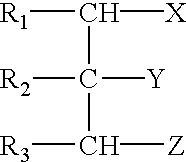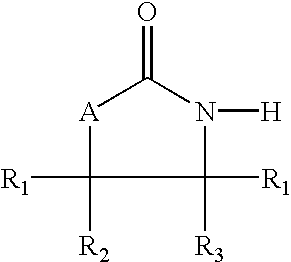Higher organic inks with good reliability and drytime
a high-reliability, dry time technology, applied in the field ofinkjet ink, can solve the problem of not simply increasing the organic content, and achieve the effect of reducing the cockle, reducing the water content of the ink, and reducing the cockl
- Summary
- Abstract
- Description
- Claims
- Application Information
AI Technical Summary
Benefits of technology
Problems solved by technology
Method used
Image
Examples
example 1
Table I below tabulates the curl for three different inks, wherein "Ink 1" has the formulation listed above, "Ink 1+10% 2P" is Ink 1 plus 10 wt % 2-pyrrolidone, and "Control" is commercially available as HP C4844A black ink. Table I shows that the addition of a minimal amount of only 10 wt % 2-pyrrolidone to a basic ink jet formulation greatly improves the expected pen life ("plot suite" is a measure of pen life, wherein the higher the value, the longer the pen life) and stops curl.
example 2
The inks may be underprinted with a fixer. An example of a suitable fixer composition is listed in Table II below.
The fixer may also contain the anti-cockle / curl additives of the present invention, but the most effective use of these additives is in the high organic ink itself. The precipitation or immobilization of the colorant is also important to drytime, and the fixer combined with the ink precipitates the colorant to give essentially instantaneous drytime on plain papers. Cockle / curl are a separate issue, which can be helped by the addition of these solvents (the removal of water).
Table III below compares the results of Ink 2 and Ink 2 plus 10 wt % 2-pyrrolidone ("10% 2P"). Specifically, Table III lists the average OD on the five plain papers enumerated above, the average OD with underprinting, the drytime on Champion Data Copy (CDCY), the drytime with underprinting, the bleed on CDCY, the bleed with underprinting, the curl on CDCY with underprinting, the % strike through, and ...
example 3
Table IV below compares the results of Ink 3 alone and with (a) plus 20 wt % 2-pyrrolidone, (b) plus 10 wt % glycerol, and (c) plus 20 wt % glycerol. The same headings as in Table III above are also in Table IV.
Again, underprinting increases the optical density (OD). Increasing the organic content (e.g., +20 wt % glycerol) negatively impacts drytime without underprinting. But with underprinting, drytime is instantaneous in all cases. Underprinting also eliminates bleed even at high total organic content. Curl improves when the high organic content (2-pyrrolidone or glycerol in this example) is added and the fixer eliminates any negative impacts to drytime, bleed, and strikethrough.
The addition of high organic solvents also improves pen life from reduced outgassing as shown in Table I.
The foregoing examples have been directed to employing 2-pyrrolidone and glycerol as the high organic co-solvent. Based on addition information, ethylhydroxypropanediol, 3-methyl-1,3,5-pentanetriol, 1,6...
PUM
| Property | Measurement | Unit |
|---|---|---|
| wt % | aaaaa | aaaaa |
| temperature | aaaaa | aaaaa |
| surface tension | aaaaa | aaaaa |
Abstract
Description
Claims
Application Information
 Login to View More
Login to View More - R&D
- Intellectual Property
- Life Sciences
- Materials
- Tech Scout
- Unparalleled Data Quality
- Higher Quality Content
- 60% Fewer Hallucinations
Browse by: Latest US Patents, China's latest patents, Technical Efficacy Thesaurus, Application Domain, Technology Topic, Popular Technical Reports.
© 2025 PatSnap. All rights reserved.Legal|Privacy policy|Modern Slavery Act Transparency Statement|Sitemap|About US| Contact US: help@patsnap.com



